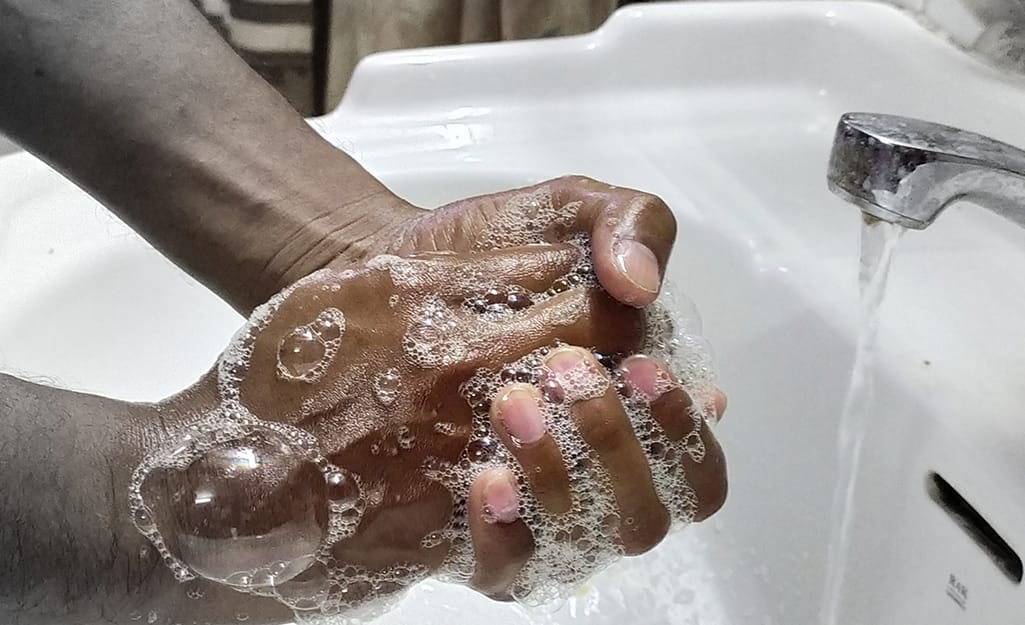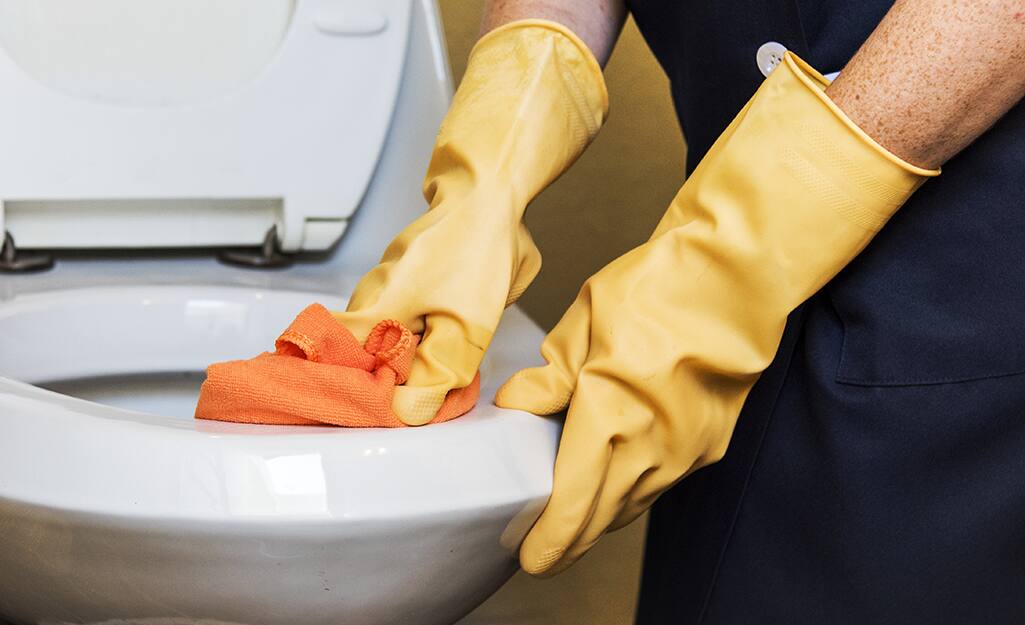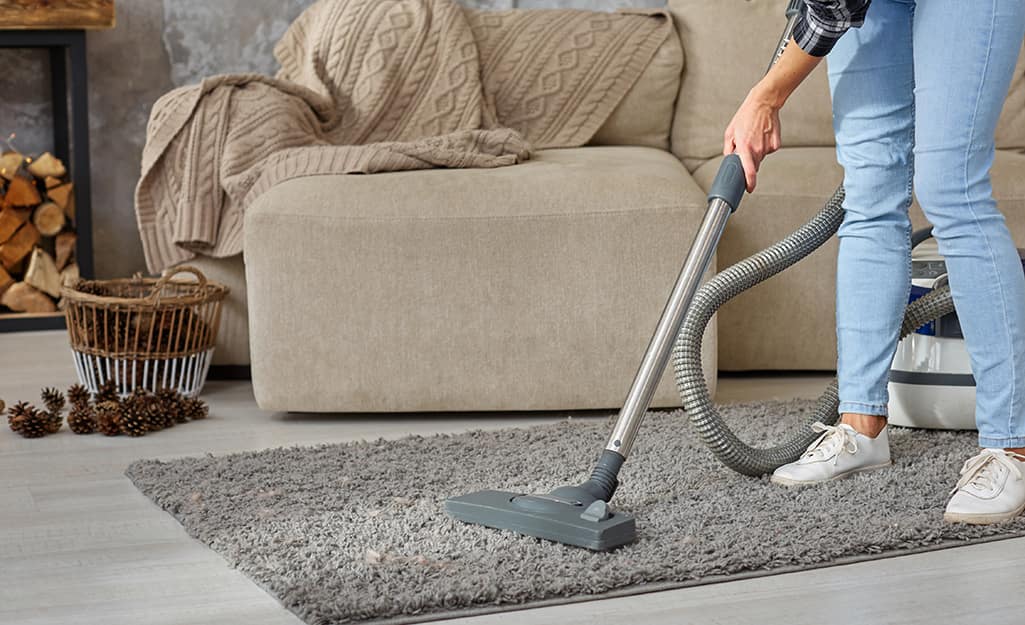Project Guide
How to Disinfect a House
Knowing how to disinfect a house is important all year-round, but it’s especially important during cold and flu season. While you may know how to clean the house effectively, cleaning is only one part of the process. Disinfecting will reliably kill germs and viruses to help prevent illnesses. This guide will teach you how to disinfect a house completely, including how to disinfect furniture and bonus tips for when a family member is sick.
Tools
- Cleaning Buckets
- Disposable Gloves
- Electronics Cleaning Cloths
- Paint Respirators
- Rubber Gloves
- Scrub Brushes
- Sponges
- Upright Vacumms
Materials
- All Purpose Cleaners
- Carpet Cleaners
- Cleaning Wipes
- Disinfecting WIpes
- Garbage Bags
- Hand Sanitizers
- Hand Soaps
- Laundry Detergent
- Shower & Bathtub Cleaner
- Upholstery Cleaner
1. Cleaning Tips

Follow these tips when you start cleaning and disinfecting your home:
- Wear disposable gloves or reusable rubber gloves.
- Clean using soap and water or an all-purpose cleaner. Then follow-up with an EPA-approved disinfectant.
- Always clean and launder according to the manufacturer’s instructions on both your cleaner and the item you’re cleaning.
- Gather all your cleaning supplies in a caddy or bucket to keep them organized and to easily carry them from room to room.
- Pick up clutter before you start cleaning.
- To make cleaning the whole house easier, start with one task (such as dusting or vacuuming) and do that task in every room before moving on to the next task.
- Sweep before mopping.
- Make a DIY all-purpose cleaner by combining 4 tablespoons of baking soda with 1 quart of warm water. Use a sponge to apply it and scrub away messes on surfaces.
- If an EPA-approved disinfectant is not available, use a bleach to water ratio for cleaning and disinfecting. Use a bleach that contains 5-1/4 to 8-1/4 percent sodium hypochlorite. Add 4 teaspoons of bleach for every quart of room temperature water or add 1/3 cup of bleach for every gallon of room temperature water.
- Alcohol solutions with at least 70 percent alcohol can also be used as a disinfectant.
- Use any DIY cleaners or disinfectants within 24 hours of making them.
- Remember to wash and disinfect your cleaning tools regularly.
- Always wash your hands with soap and warm water after using cleaning products. Remember to lather for at least 20 seconds before rinsing.
2. Cleaning vs. Disinfecting

While sometimes used interchangeably, cleaning and disinfecting are two different processes. Cleaning physically removes germs, dirt, and grime using soap (or other cleaner) and water. Cleaning doesn’t necessarily kill germs, but it does lower the number of germs and the risk of infection.
Disinfecting uses chemicals to kill germs on surfaces and objects. Disinfecting typically doesn’t remove the germs or dirt, but since the germs are dead, the risk of infection and illness is much lower. When trying to prevent viruses, disinfection is an essential step.
Whenever you plan to both clean and disinfect a surface, always clean first and then disinfect.
Tip: Disinfectant needs time to work and should sit on a surface for as long as recommended by the manufacturer. Typically, this amount of time is 5 to 10 minutes.
3. How to Clean the House

Some areas of your home you can clean regularly without having to disinfect as often. For example, windows might need to be cleaned to remove dirt, but they rarely need to be disinfected. However, frequently touched appliances, like door handles and light switches, need to be both cleaned and disinfected often to prevent the transfer of illnesses.
It’s a good habit to practice routine cleaning of all the surfaces you use and touch often. These surfaces include:
- Tables
- Countertops
- Desks
- Light switches
- Handles and knobs
- Keyboards
- Phones
- TV remotes
- Faucets and sinks
- Toilet seats, lids and handles
- Refrigerator door
Cleaning routinely will make your deep cleans easier and quicker. After you clean these surfaces in your house, thoroughly cleaning the kitchen and bathrooms should be the next priority on your cleaning checklist.
4. How to Disinfect the Kitchen

Once you have a cleaning routine, you can approach how to disinfect a house. Since the kitchen is a high-traffic area and where you prepare all your food, you should disinfect it regularly and whenever you do a deep clean.
- Most disinfectants are not safe to use in food prep areas unless you rinse the surfaces after disinfecting.
- Spray or wipe down all handles, control panels, faucets and hard surfaces with a disinfectant.
- Allow the surfaces to stay wet with the disinfectant for the appropriate amount of time. If you are using disinfecting wipes, allow the surfaces to air dry.
- After allowing the disinfectant to set, rinse all the disinfected surfaces using clean water and a cloth or paper towel.
- Wash dishes, glasses, and utensils using hot water and dish soap or in a dishwasher.
- All trash cans, especially kitchen trash cans and any that hold food waste, should be lined with a trash bag. Clean and disinfect the trash can lid regularly. Disinfect the interior of the trash can every time you take out the trash and before putting in a new bag.
- To clean a garbage disposal drain, pour 1/2 cup of baking soda into the drain. Then pour 1/2 cup of vinegar into the drain. Allow the baking soda and vinegar mixture to bubble and sit in the drain for an hour. After an hour, run cold water and turn on the garbage disposal for one minute. Note that vinegar can degrade the disposal over time, so use this method sparingly. More frequently rinse out the disposal by simply turning on the disposal and running hot water for one minute.
- A mixture of 1/2 cup baking soda and 1/2 cup vinegar can also be used to clear slow drains in other sinks. Always flush the mixture afterwards by running cool water.
Tip: Cleaning and disinfecting products can damage some countertop materials. Make sure the products you use are compatible with your type of countertop.
5. How to Disinfect the Bathroom

Every time you clean the bathroom, it’s a good idea to disinfect it as well.
- Spray or wipe down all handles, faucets, and hard surfaces with a disinfectant and allow the disinfectant to set.
- Disinfectant wipes are a convenient way to regularly disinfect the toilet seat, lid and handles, as well as faucet handles.
- Use a toilet bowl cleaner to best clean and disinfect the inside of the toilet bowl and under its rim. Because toilet bowl cleaner usually needs to rest on the surface for a while to be effective, squirt it into the bowl when you first start cleaning the bathroom. Then return to fully clean the toilet after cleaning the rest of the bathroom.
- Use a scrub brush as needed in showers, bathtubs and toilets to remove built-up grime, mold and mildew.
- Wipe down mirrors and glass with a microfiber cloth and glass cleaner. Use a dry microfiber cloth to remove any remaining cleaner that might cause spotting or streaks.
- Replace hand towels daily.
- Regularly launder all towels and bathmats.
6. How to Disinfect Soft Surfaces

Whenever possible, wash soft items in a washing machine using hot water. Depending on their material, you can typically launder clothes, drapes, bedding, and furniture covers at home or at a laundromat. Disinfecting other soft surfaces, such as carpets and couches, can be more difficult.
Here’s how to disinfect a carpet or rug:
- Move furniture as needed.
- Vacuum the carpet as usual.
- Clean the carpet with a carpet cleaner you trust. Always perform a patch test when using a new cleaner or when applying to a new carpet to ensure the cleaner won’t damage your carpet.
- The best way to disinfect a carpet is with a steam cleaner. You can use just water to steam clean, or you can add the appropriate amount of carpet detergent to also clean any stains.
- After steam cleaning, allow the carpet to completely dry before walking on it or replacing furniture.
- For disinfecting without a steam cleaner, apply a disinfectant spray that states on the label it can be used on soft surfaces. Do a patch test first.
- After the disinfectant rests for the right amount of time, vacuum the carpet again.
- Allow the carpet to dry before replacing furniture.
Here’s how to disinfect a couch:
- Vacuum the couch thoroughly, being sure to get between and below all the cushions.
- If the upholstery on the cushions can be removed and washed, wash them in a washing machine at the highest temperature that is safe for the fabric.
- Use disinfectant wipes to wipe down any non-upholstery parts of the couch.
- Use a disinfectant spray approved for soft surfaces on the upholstered parts of the couch.
- If you have a leather couch, you can clean it with a mixture of equal parts water and vinegar. Use a soft cloth to wipe down the leather with the solution. Make sure the cloth is damp but not sopping wet.
- To remove odors on an upholstered couch, use baking soda. Do a patch test first to make sure the baking soda won’t lighten the fabric. Spread a generous amount of baking soda evenly across the couch using a bristle brush. Let the baking soda layer sit for a few hours undisturbed. Vacuum up the baking soda.
When doing laundry, follow these tips:
- Use the hottest possible water that won’t damage your fabrics. Check labels for the water temperature recommendations.
- Allow laundry to dry completely before putting away.
- Never shake dirty laundry, as this can send dirt and germs into the air.
- Remember to clean and disinfect laundry hampers between laundry cycles.
Tip: If you have children and/or pets, remember to thoroughly rinse any soft materials that may end up in a mouth after being disinfected.
7. How to Disinfect Electronics

Before trying to disinfect electronics, always check their manufacturer’s instructions for cleaning.
- Never spray disinfectant directly onto your electronics.
- Clean screens with a damp microfiber cloth.
- Use compressed air to remove crumbs from keyboards and remotes.
- To disinfect, combine equal parts rubbing alcohol and water. Dampen a microfiber cloth with the solution and wipe down the surfaces of your electronics. Dry screens with another microfiber cloth.
- For TV screens, avoid using disinfectant or other chemicals. Simply wipe down with water and a microfiber cloth.
Tip: Consider buying a wipeable screen protector for your smartphone that you can disinfect often.
8. Air Filtration

Keeping your HVAC system clean and filtered will help reduce the transmission of airborne illnesses in your home.
- Replace HVAC filters regularly (usually every three months) and make sure they are properly in place.
- Consider upgrading your filters to the highest-rated types your system can accommodate.
- HVAC systems only filter air when the fan is running. Consider running the fan for longer or continuously, especially when a household member is sick.
- An air purifier can help reduce contaminants in the air, including allergens, germs and viruses. Remember that air purifiers have a limited effective range and also have filters that need to be changed or cleaned regularly.
Safety Note: Running your HVAC fan or an air purifier is not enough to prevent illness. Combine these efforts with routine cleaning and disinfecting in all areas of your home.
9. How to Clean When Someone Is Sick

Take these extra precautions when a household member is sick:
- If possible, have the sick person self-quarantine to a single bedroom and bathroom. If you must share a bathroom, the sick person should clean and disinfect after themselves. If they’re not well enough to do so, wait as long as possible before disinfecting the area yourself before use.
- Have dedicated trash bins for the sick person to use and make sure those trash bins are lined with a bag.
- Have the sick person launder their own clothes and sheets if they’re well enough.
- Wear disposable gloves when doing the sick person’s laundry. Their laundry can be washed with other family member’s dirty laundry.
- Wear a mask and disposable gloves whenever cleaning for, or in close contact with, the sick person.
- Replace the toothbrush after the illness has passed.
- Both the caregiver(s) and sick person should wash their hands regularly and frequently for at least 20 seconds.
Now that you know how to disinfect a house, you can help keep yourself and your family healthy throughout the year. Practice routine cleaning and disinfect high-touch areas like countertops and electronics frequently. Want to have disinfecting and cleaning products on hand whenever you need to clean? Our repeat-delivery subscription service doesn’t require a membership fee.
